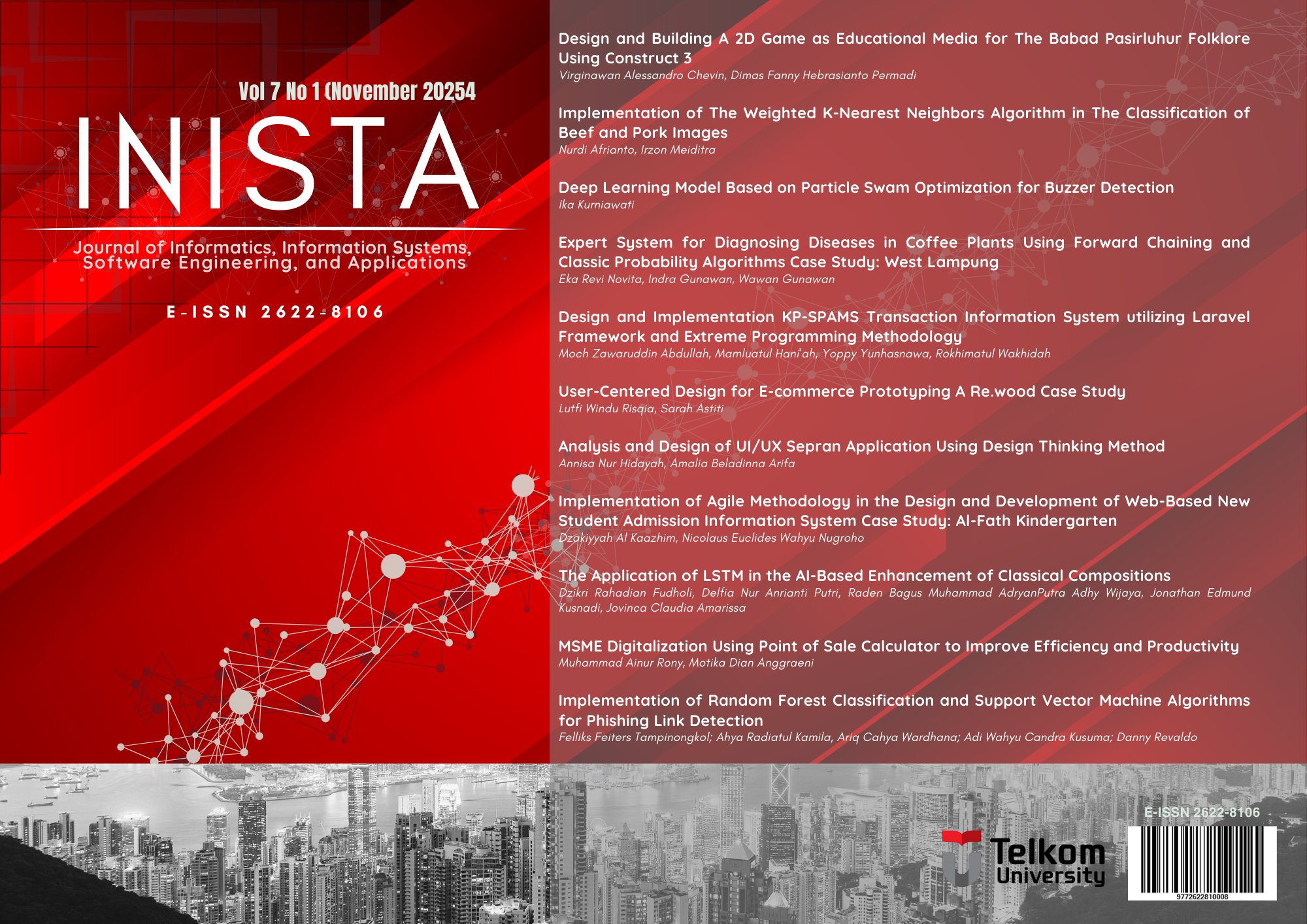MSME Digitalization Using Point of Sale Calculator to Improve Efficiency and Productivity
Main Article Content
Abstract
Digitalization of Micro, Small, and Medium Enterprises (MSMEs) in Indonesia is crucial to increase competitiveness in the era of globalization. Due to cost considerations, many MSMEs continue to rely on conventional methods to manage their businesses, leading to inefficiencies in transaction handling and sales data analysis. This traditional approach often results in errors, reporting delays, and suboptimal decision-making, which can hinder growth and productivity. This study focuses on the implementation of a free cloud-based Point of Sale (POS) calculator application as a digital solution to address these challenges. The POS application streamlines the transaction process and generates real-time sales reports, ultimately improving operational efficiency and strategic decision-making. The development method used in this study is the System Development Life Cycle method. The POS application development process includes comprehensive Requirements Analysis, System and Software Design, Implementation, Testing, and Maintenance. User feedback was collected through structured interviews and surveys to evaluate the application's ease of use and its benefits in improving MSME operations. The findings showed significant improvements in operational efficiency, as the POS application speeds up transaction processing and provides timely, data-driven insights for decision-making.
Article Details

This work is licensed under a Creative Commons Attribution-ShareAlike 4.0 International License.
Authors who publish with this journal agree to the following terms:
- Authors retain copyright and grant the journal right of first publication with the work simultaneously licensed under a Creative Commons Attribution License (CC BY-SA 4.0) that allows others to share the work with an acknowledgement of the work's authorship and initial publication in this journal.
- Authors are able to enter into separate, additional contractual arrangements for the non-exclusive distribution of the journal's published version of the work (e.g., post it to an institutional repository or publish it in a book), with an acknowledgement of its initial publication in this journal.
- Authors are permitted and encouraged to post their work online (e.g., in institutional repositories or on their website) prior to and during the submission process, as it can lead to productive exchanges, as well as earlier and greater citation of published work.
References
[2] C. Yolanda, “Peran Usaha Mikro, Kecil Dan Menengah (UMKM) Dalam Pengembangan Ekonomi Indonesia,” J. Manaj. Dan Bisnis, vol. 2, no. 3, pp. 170–186, 2024, doi: 10.36490/jmdb.v2i3.1147.
[3] D. Hermawan, Y. Sutrayana, and Abudiman, “Point of Sales Application Development at Worm Store Workshop,” J. Mantik, vol. 6, no. 3, pp. 2685–4236, 2022.
[4] B. S. Prayogi, I. Fitri, and R. Nuraini, “Aplikasi Point of sale Berbasis Website pada Toko Sembako Tegar,” J. JTIK (Jurnal Teknol. Inf. dan Komunikasi), vol. 6, no. 2, pp. 260–266, 2022, doi: 10.35870/jtik.v6i2.411.
[5] R. Inggi, Y. Prayudi, and B. Sugiantoro, “Penerapan System Development Life Cycle (Sdlc) Dalam Mengembangkan Framework Audio Forensik,” SemanTIK, vol. 4, no. 2, pp. 2502–8928, 2019, doi: 10.5281/zenodo.2528444.
[6] A. Kusmawati and W. S. Utami, “KLIK: Kajian Ilmiah Informatika dan Komputer Pengembangan Aplikasi Point of Sale untuk Meningkatkan Kinerja Agen Softdrink Menggunakan Metode Prototype,” Media Online), vol. 4, no. 2, pp. 1121–1133, 2023, doi: 10.30865/klik.v4i2.1300.
[7] K. Telaumbanua, F. S. Damanik, M. Alhami, and E. Suparnap, “Pengembangan Sistem Point of Sales Menerapkan Pendekatan PIECES,” RESOLUSI Rekayasa Tek. Inform. dan Inf., vol. 3, no. 6, pp. 291–298, 2023.
[8] A. Lutfi Irawan, A. Triayudi, and A. Iskandar, “Implementasi Sistem Point of Sales Menggunakan Metode Agile Development,” Media Online), vol. 3, no. 6, pp. 1326–1333, 2023, doi: 10.30865/klik.v3i6.940.
[9] Fitria Anisa, Fauzi Syahputra Harahap, Harits Al Khosyi, Intan Permata Sari, and Yahfizham, “Pengembangan Software Menggunakan Model SDLC Guna Mencapai Keselarasan dengan Kebutuhan Pengguna,” J. Informatics Busisnes, vol. 01, no. 04, pp. 229–232, 2024, [Online]. Available: https://jurnal.ittc.web.id/index.php/jibs/index
[10] N. Hasanah and M. N. Indriawan, “Rancangan Aplikasi Batam Travel Menggunakan Metode Software Development Life Cycle (SDLC),” Comb. - Conf. Manag. Business, Innov. Educ. Soc. Sci., vol. 1, no. 1, pp. 925–938, 2021, [Online]. Available: https://journal.uib.ac.id/index.php/combines/article/view/4524
[11] Ichsan Raksa Gumilang, “Penerapan Metode Sdlc (System Devlopment Life Cycle) Pada Website Penjualan Produk Vapor,” Jural Ris. Rumpun Ilmu Tek., vol. 1, no. 1, pp. 47–56, 2022, doi: 10.55606/jurritek.v1i1.144.

